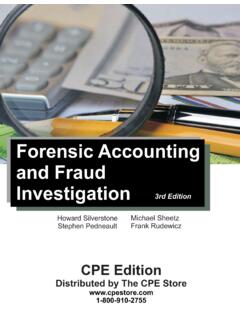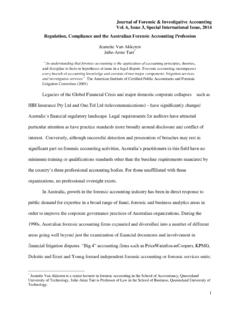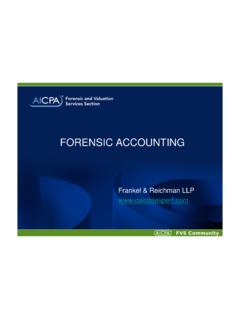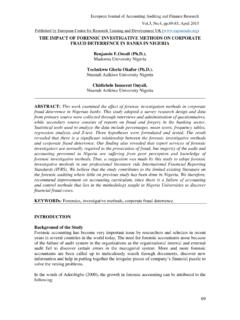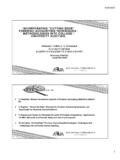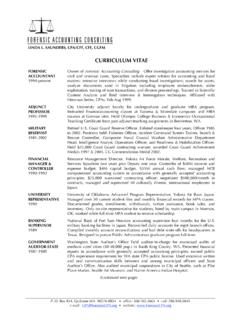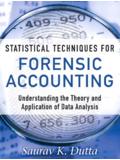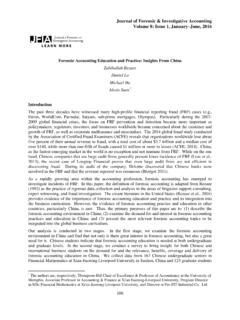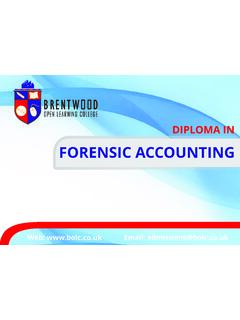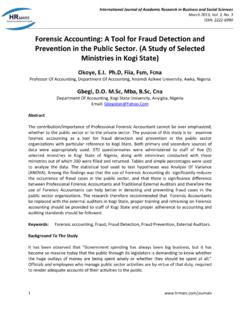Transcription of Forensic Accounting and Fraud Investigation 4th Edition Text
1 Forensic Accounting and Fraud Investigation 4th Edition Stephen Pedneault Frank Rudewicz Michael Sheetz Howard Silverstone Table of Contents Preface .. v About the Authors .. vi Chapter 1 Forensic Accounting .. 1 Learning Objectives .. 1 What Is Forensic 1 Why Has Forensic Accounting Become the Buzz? .. 2 Introduction to a Profession .. 3 Applications for Forensic 3 A Third Dimension: Contexts within Each Area of Specialization .. 6 8 Review Questions .. 9 Review Answers .. 10 Chapter 2 Fraud in Society .. 11 Learning Objectives .. 11 What Is Fraud ? .. 11 Types of Fraud .. 13 Other Types of Financial Fraud .. 16 Sarbanes-Oxley .. 17 What the Numbers Tell Us about Fraud .. 17 Categories of Occupational Fraud .. 18 Drawing Conclusions .. 20 Society s Perception of Fraud .. 20 Who Commits Fraud ? Profile of the Typical Fraudster.
2 21 The Social Consequences of Economic Crime .. 25 25 Review Questions .. 26 Review Answers .. 28 Chapter 3 Understanding the Basics of Financial 31 Learning Objectives .. 31 Where It All Begins .. 31 The Five Accounting Cycles .. 33 Journals: Subsidiary and General .. 37 38 Review Questions .. 40 Review Answers .. 41 Chapter 4 Forms of Entities .. 43 Learning Objectives .. 43 Basics of Business Structures .. 43 Sole Proprietorships .. 43 Partnerships .. 44 Corporations .. 45 Business Enterprises in the Global Environment .. 47 50 Review Questions .. 51 Review Answers .. 52 Chapter 5 Fundamental Principles of Financial Analysis .. 53 Learning Objectives .. 53 Good Analysis = Due Diligence? .. 53 Why Perform Financial Analysis? .. 54 Table of Contents ii What and Whom Can You Trust?.. 55 Other Factors to Consider .. 55 Financial Analysis for the Non-Expert.
3 56 To the Future .. 60 61 Review Questions .. 62 Review Answers .. 63 Chapter 6 The Role of the Accounting Professional .. 65 Learning Objectives .. 65 The Importance of Accounting Professionals in the Investigation .. 65 The Audit Process .. 68 Internal Controls .. 71 72 Review Questions .. 73 Review Answers .. 75 Chapter 7 Business as a Victim .. 77 Learning Objectives .. 77 77 Employee Thefts .. 77 Fraudulent Billing Schemes .. 81 Fraud Committed by Outsiders .. 81 Management Thefts .. 82 Corporate Thefts .. 84 Identity Theft .. 84 86 Review Questions .. 87 Review Answers .. 88 Chapter 8 Business Villains .. 91 Learning Objectives .. 91 91 Organized Crime and Business .. 91 Money Laundering .. 97 101 Review Questions .. 102 Review Answers .. 103 Chapter 9 The Investigative Process .. 105 Learning Objectives.
4 105 105 Case Initiation .. 105 Case Evaluation .. 106 Solvability 107 Goal Setting and Planning .. 108 Investigation .. 113 Background .. 114 119 Review Questions .. 121 Review Answers .. 123 Chapter 10 Interviewing Financially Sophisticated Witnesses .. 125 Learning Objectives .. 125 125 The Interview .. 125 Interviewing Financially Sophisticated Witnesses .. 136 Table of Contents iii 138 Review Questions .. 139 Review Answers .. 140 Chapter 11 Proving Cases through Documentary Evidence .. 143 Learning Objectives .. 143 143 Document Collection .. 143 Document Organization .. 152 The Process of Proof .. 155 The Logic of Argument .. 156 Proof through Inference .. 159 161 Review Questions .. 163 Review Answers .. 165 Chapter 12 Analysis Tools for Investigators .. 167 Learning Objectives .. 167 167 Why Use Analysis Tools at All?
5 167 Associational Analysis .. 168 Temporal Analysis .. 181 185 Review Questions .. 186 Review Answers .. 187 Chapter 13 Inferential Analysis .. 189 Learning Objectives .. 189 189 How Inferential Analysis Helps .. 189 What Is an Inference Network? .. 189 Investigative Inference Analysis .. 191 The Key List .. 195 Constructing an Investigative Inference Chart .. 195 Plotting the Chart .. 198 Some Tips for Charting Success .. 201 Applying the Chart to the Investigative Process .. 201 202 Review Questions .. 204 Review Answers .. 205 Chapter 14 Documenting and Presenting the Case .. 207 Learning Objectives .. 207 207 Creating a System .. 207 The Casebook System .. 207 Report 212 Testifying as a Financial Expert .. 214 224 Review Questions .. 225 Glossary .. 227 Index .. 229
